As part of spiritual research using UTS (Universal Thermo Scanner) technology to study the effects at the spiritual level of offering a coconut to Deities during the ‘Bagalamukhi-Brahmastra Yaga’ and ‘Mahaganapati Hom’
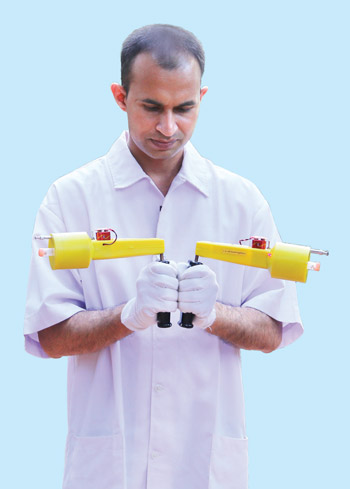
1.Purpose of the scientific experiment
For all obstacles in the path of establishing the ‘Hindu Nation’ and difficulties being faced by seekers to get eliminated, ‘Bagalamukhi-Brahmastra Yaga’ was performed in Sanatan’s Ramnathi Ashram on 4th and 5th November 2016 on the advice of Bhrugu Maharshi.
On the advice of Maharshis through Saptarshi Jivnadipatti, a special ‘Ganapati Hom’ and ‘Brahmastra Yaga’ too were performed on 6th November 2016, the day of ‘Uttarashadha’ Nakshatra (which is the Nakshatra of Paratpar Guru (Dr.) Athavale.
During the Brahmastra Yaga, Shri Bagalamukhi Devi, Shri Kalbhairav and Navagraha Deities were worshipped. During the worship, the Deities were offered Shriphal (Coconuts).
To study the spiritual benefits of offering Shriphal during ritualistic worship, an experiment was conducted using UTS technology on 7th November 2016.
2. Nature of the experiment
In this experiment, the readings of an ordinary coconut, coconuts used in the above mentioned ritualistic worship (that subsequently developed a crack) as well as that which did not crack were taken using UTS equipment. A comparative study of all the readings was done.
3. Information on components used in the experiment
Coconut has the ability to attract and emit the vibrations of Deities and hence, is considered to be the most auspicious fruit. This is why a coconut is offered to Deities during ritualistic worship. (More information on Shriphal and other components of ritualistic worship is given in Sanatan’s Holy text – Importance of substances used in ritualistic worship.)
3A. Ordinary Coconut
3B. Coconut used in ritualistic worship that subsequently developed a crack
Vibrations of the Deity being worshipped are attracted to the coconut being offered to the Deity in ritualistic worship and are then emitted into the atmosphere. To prevent this, negative energies attack the coconut and it develops cracks. Of the 6 coconuts offered to the Deities during the ‘Bagalamukhi-Brahmastra Yaga’ and ‘Mahaganapati Hom’, 4 developed cracks. The coconut used for the experiment is one of these 4.
Negative energies : There are positive as well as negative energies in the environment. Since seekers perform spiritual practice, positive energies are attracted towards them. As a result, there is an increase in the positive energies and reduction in the negative energies. To prevent this, negative energies create obstacles in the spiritual practice of seekers. In the Holy Puranas, there are many stories of demons creating obstacles in the Yadnyas (Sacrificial fires) performed by the Sages and Ascetics.
3C. Coconut used in ritualistic worship that did not develop cracks
This is one coconut offered to the Deities during the ‘Bagalamukhi-Brahmastra Yaga’ and ‘Mahaganapati Hom’. Four coconuts developed cracks; but this did not.
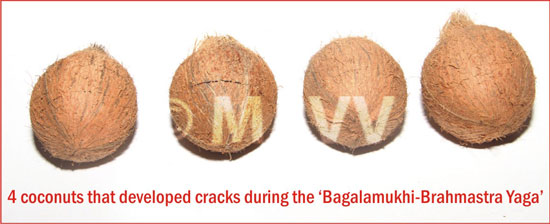
4. Measuring the aura with UTS
4A. About UTS
This instrument is also known as an ‘aura scanner’. By using this, the energy and the aura of an object can be measured. This was developed in 2003 by Dr. Mannem Murthy, a former nuclear scientist. He says that the UTS can be used for identifying obstacles in a premises and in medical science, animal husbandry, Vedic science etc.
4B. Various components of the experiment with this instrument and interpretations
4B 1. Negative energy : This energy is harmful. It is basically of two types :
A. Infrared : Under this, infrared energy emitted by an object is measured.
B. Ultraviolet : Under this, the ultraviolet energy emitted by an object is measured.
4B 2. Positive energy : This is a helpful energy, and to measure it, a sample of +ve energy is placed in the scanner.
4B 3. Measuring the aura of an object using the UTS : To measure the aura of an object, a sample that has maximum vibrations of the object is taken; for example, when the aura around an individual is to be measured, the individual’s saliva or a photo; for an inanimate object, a picture; for a plant, its leaf; for an animal, its hair; for a premises, its mud or dust; in case of a Deity’s Idol, the sandalwood paste, shendur (An orange powder used in rituals) etc. applied to the Deity.
4C. Method of taking readings using UTS
First an object emitting infrared energy is placed in the UTS. Then, the individual conducting the experiment holds the scanner in a specific manner and stands about a foot away from the object under experiment. At this time, the angle between the two arms of the scanner shows the extent of infrared energy in the object. For example, if the arms of the scanner form a 180o angle, it means that the object is completely filled with infrared energy; if the arms do not open at all (meaning, the angle is 0o), it means that there is no infrared energy at all in it.
If the arms open at 180o, move away from the object and note the distance at which this angle remains steady. This distance is the extent of the object’s aura. If the arms of the scanner open at an angle less than 180o, it implies that there is no infrared aura around the object. Similarly, the aura of ultraviolet energy, positive energy and specific vibrations in the object are measured.
5. Precautions taken for consistency in the readings
A. The individual handling the instrument was not suffering from any spiritual distress (meaning, he had no negative vibrations).
B. The individual handling the instrument wore white clothes so that the colour of the clothes does not affect the experiment being conducted.
6. Observations made using the UTS, their analysis and conclusions (See Table A)
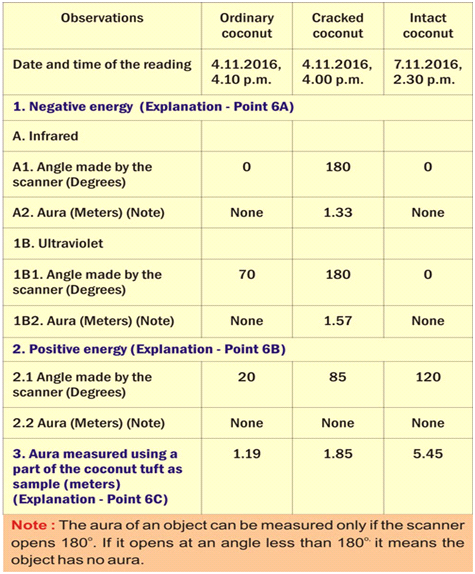
6A. Analysis of observations on negative energy in the table
6A 1. When compared with the ordinary coconut, the coconut used in the ritualistic worship (that subsequently developed a crack) had a lot more negative energy : When an ordinary coconut was tested, it showed some amount of ultraviolet energy (meaning, negative energy); however, when the coconut used in the ritualistic worship (that subsequently developed a crack) was tested, it showed a lot of infrared and ultraviolet (negative) energy. The infrared and the ultraviolet energy is being emitted in an area covering a radius of 1.33 meters and 1.57 meters respectively. From these observations we can conclude that the coconut that developed cracks was attacked by negative energies, and as a result instead of positive energy, negative energy was emitted by it.
6A 2. The coconut used in ritualistic worship (that did not develop a crack) showed no signs of negative energy : An ordinary premises or object can have negative energy; however, upon testing the coconut used in this ritualistic worship (that did not develop a crack), it was found that it had no negative energy at all.
6B. Analysis of observations about the positive energy
6B 1. When compared with the ordinary coconut and the cracked coconut, the coconut used in the ritualistic worship that did not develop cracks had a lot more positive energy :There may not be positive energy in every premises or object; however, the ordinary coconut and the coconut used in ritualistic worship (that did not develop cracks) had some amount of positive energy; because, coconut is basically a sattvik fruit. The coconut in the ritualistic worship that did not crack showed maximum amount of positive energy; because, it had imbibed Divine vibrations.
6C. Analysis of observations associated with the auras
6C 1. When compared with the ordinary coconut and the cracked coconut, the aura of the coconut used in the ritualistic worship that did not crack was much more : The aura of an ordinary man is about 1 meter. The aura of an ordinary coconut is 1.19 meters, whereas the aura of the cracked coconut is 1.85 meters; meaning, it is more when compared with the aura of an ordinary man. The aura of the coconut (that had not cracked) is 5.45 meters, meaning, a lot more when compared with the aura of the other two coconuts. It did not crack because it had imbibed Divine vibrations.
7. Conclusion
It is proved through this scientific experiment that the coconuts offered to Deities in ritualistic worship have the ability to imbibe and emit the vibrations of Deities, and this helps the society at the spiritual level. The experiment also highlighted the manner in which negative energies create obstacles so that we do not get the benefit of Chaitanya generated through ritualistic worship.
Our Sages and Ascetics have very thoughtfully set up a system of various rituals in Hindu Dharma and various constituents (such as haldi-kumkum [Turmeric powder and red powder made from it], akshata [Unbroken rice grains, usually smeared with kumkum], betel nuts, flowers & leaves, fruits etc.) used in worship. It is very evident that each religious ritual in Hindu Dharma is a scientifically proven experiment. Blessed are the Sages & Ascetics (and the Hindu Dharma) who gave this invaluable treasure to mankind !
Mrs. Madhura Dhananjay Karve (Maharshi Adhyatma Vishwavidyalay, 14.11.2016)
E-mail : savv.research@gmail.com

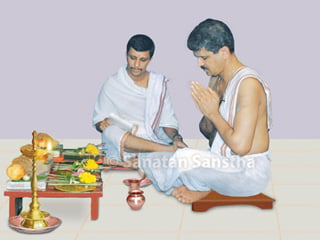 Maharshi Adhyatma Vishwavidyalay conducts novel spiritual research
Maharshi Adhyatma Vishwavidyalay conducts novel spiritual research Unique research explaining the spiritual significance of Vatapournima
Unique research explaining the spiritual significance of Vatapournima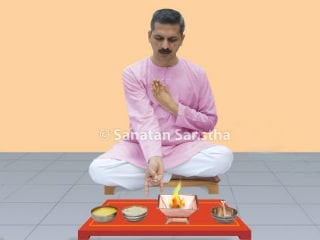 Scientific research on ‘agnihotra’, a precursor of a yadnya (fire sacrifice)
Scientific research on ‘agnihotra’, a precursor of a yadnya (fire sacrifice)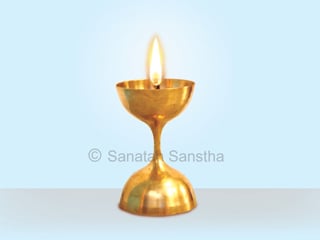 Subtle effects of lighting a plastic lamp with an electric bulb , a wax lamp...
Subtle effects of lighting a plastic lamp with an electric bulb , a wax lamp... Scientific experiment performed using UTS to examine the Ucchishta Ganapati yadnya performed by H.H. Rambhauswami
Scientific experiment performed using UTS to examine the Ucchishta Ganapati yadnya performed by H.H. Rambhauswami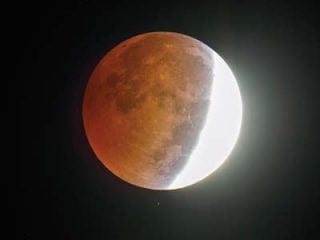 Effects of the eclipse on the states of the Guru, Sadguru and Paratpar Guru
Effects of the eclipse on the states of the Guru, Sadguru and Paratpar Guru